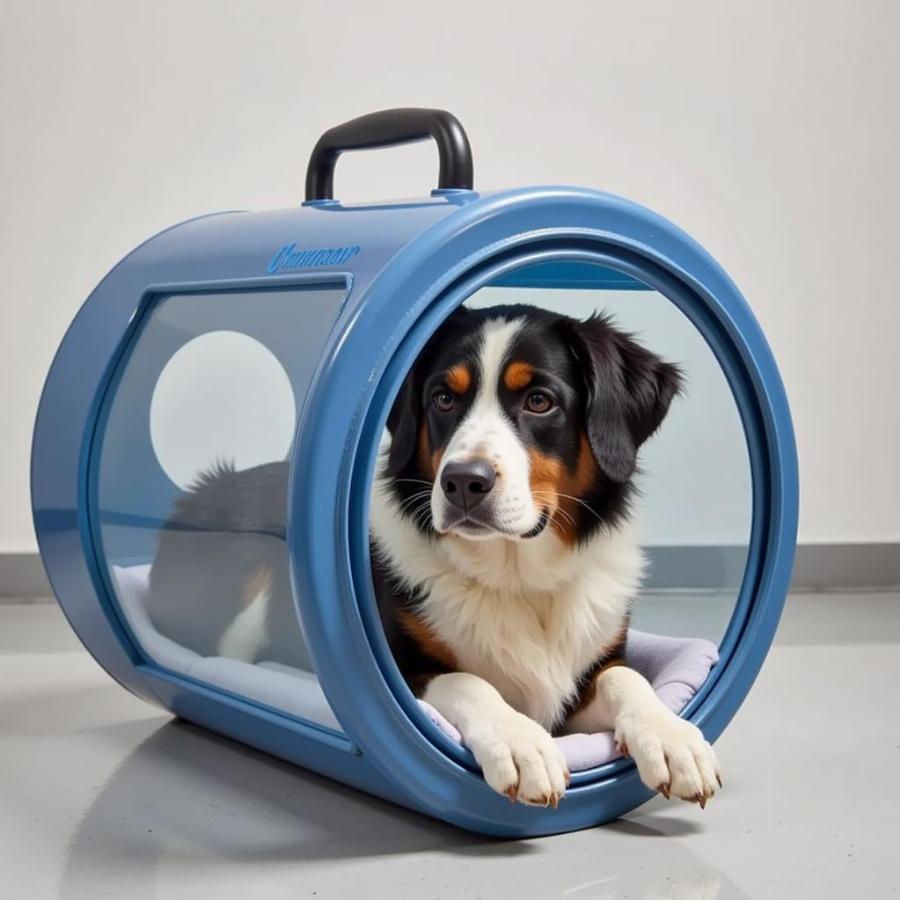Oxygen therapy, specifically using an oxygen chamber for dogs, is becoming increasingly recognized as a valuable tool in veterinary medicine. It can be a life-saver in emergencies and a powerful support for dogs battling various health conditions. This article dives deep into the world of oxygen chambers for dogs, exploring their benefits, uses, and what owners need to know.
Understanding the Need for Oxygen Chamber for Dogs
When a dog’s body isn’t receiving enough oxygen, a condition known as hypoxia, serious health complications can arise. Hypoxia can be caused by a variety of factors, from respiratory illnesses like pneumonia to heart conditions, trauma, and even heatstroke. An oxygen chamber provides a controlled environment with a higher concentration of oxygen than normal air, helping to restore oxygen levels to normal and support vital organ function.  Chó trong buồng oxy
Chó trong buồng oxy
Benefits of Oxygen Therapy for Dogs
Oxygen therapy, often administered via an oxygen chamber, offers numerous benefits for dogs suffering from various ailments. It can help improve breathing, reduce stress on the heart and lungs, enhance tissue healing, and even decrease brain swelling after trauma. For dogs undergoing surgery, oxygen therapy can be crucial for maintaining stable oxygen levels during and after the procedure.
When is an Oxygen Chamber Necessary?
Several situations may warrant the use of an oxygen chamber for dogs. These include:
- Respiratory Distress: Conditions like pneumonia, asthma, and bronchitis can severely impair a dog’s ability to breathe effectively.
- Cardiac Issues: Heart failure and other heart conditions can reduce the heart’s efficiency in pumping oxygenated blood throughout the body.
- Trauma: Injuries, such as those sustained in accidents, can lead to internal bleeding and decreased oxygen flow.
- Post-Surgery Recovery: Oxygen therapy can aid in healing and recovery after surgery, especially for high-risk procedures. ventricular tachycardia in dogs
- Carbon Monoxide Poisoning: Oxygen therapy is vital in displacing carbon monoxide from the bloodstream.
- Anemia: Severe anemia can reduce the blood’s capacity to carry oxygen.
Types of Oxygen Chambers for Dogs
There are several types of oxygen chambers available for veterinary use. These include:
- Hard-Sided Chambers: These are typically made of acrylic and provide a stable and controlled environment. They are often preferred for longer-term oxygen therapy.
- Soft-Sided Chambers: These are more portable and collapsible, making them suitable for emergency situations and transport.
- Oxygen Cages: These cages provide a less confined environment but still allow for controlled oxygen delivery. where are dogs hearts
How Does an Oxygen Chamber Work?
An oxygen chamber works by creating a sealed environment where the concentration of oxygen is significantly higher than the surrounding air. This allows the dog to breathe in more oxygen with each breath, which helps to increase blood oxygen levels and improve tissue oxygenation.
Home Oxygen Therapy for Dogs
In some cases, veterinarians may prescribe home oxygen therapy for dogs. This typically involves using an oxygen concentrator and a nasal cannula or oxygen mask. While not as controlled as a chamber, home oxygen therapy can still provide significant benefits for dogs with chronic respiratory conditions. nebuliser for dogs
What to Expect During Oxygen Chamber Treatment
If your dog requires oxygen chamber therapy, your veterinarian will explain the process and answer any questions you may have. The duration of treatment will vary depending on the underlying condition and your dog’s response. Close monitoring by veterinary staff is essential to ensure the safety and effectiveness of the therapy. stages of heart failure in dogs
Is an Oxygen Chamber Safe for My Dog?
Oxygen therapy, when administered correctly by trained veterinary professionals, is generally safe for dogs. However, like any medical treatment, there are potential risks, including fire hazards if precautions aren’t taken, and oxygen toxicity with prolonged exposure to high concentrations of oxygen. older dog heavy breathing
Conclusion
Oxygen chamber therapy can be a vital tool in treating a variety of canine health issues. It can help improve breathing, support organ function, and enhance recovery. If your dog is experiencing respiratory distress or other conditions that may benefit from oxygen therapy, consult with your veterinarian to determine if an oxygen chamber is the right option.
FAQ
- How long can a dog stay in an oxygen chamber? The duration varies depending on the individual dog’s needs and condition.
- Is oxygen therapy painful for dogs? No, oxygen therapy is generally not painful.
- Can I administer oxygen therapy to my dog at home? Only with a veterinarian’s prescription and guidance.
- How much does oxygen chamber therapy cost? Costs can vary depending on the facility and duration of treatment.
- What are the signs my dog needs oxygen therapy? Signs include labored breathing, bluish gums, and lethargy.
- Are there any side effects of oxygen chamber therapy for dogs? Potential side effects include oxygen toxicity and drying of the mucous membranes.
- What are the alternatives to oxygen chamber therapy? Alternatives may include oxygen cages, nasal cannulas, or medications.
Beaut Dogs is your trusted source for all things canine. We provide expert advice and valuable resources to help you understand and care for your beloved companion. For any questions or concerns, please contact us at Email: [email protected]. Beaut Dogs is committed to helping you navigate the wonderful world of dog ownership.